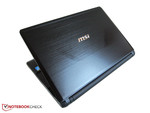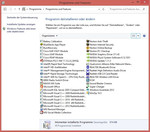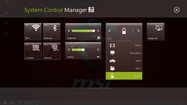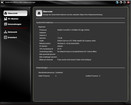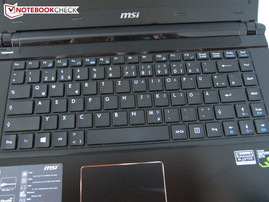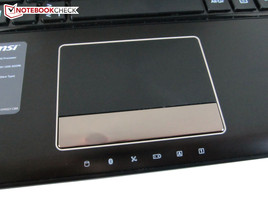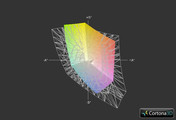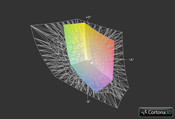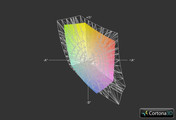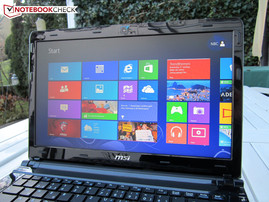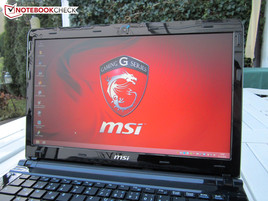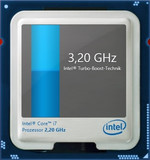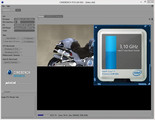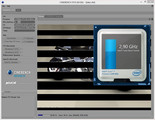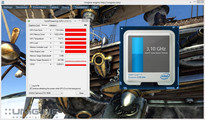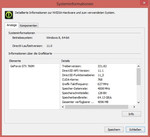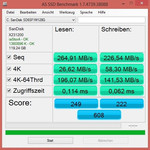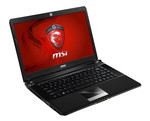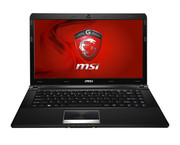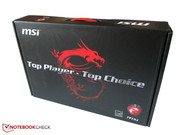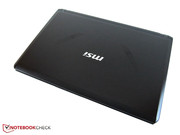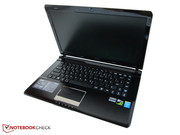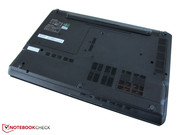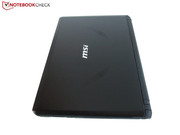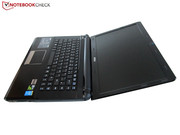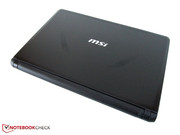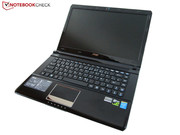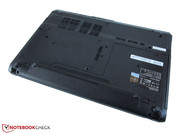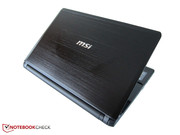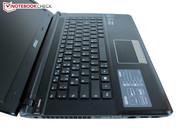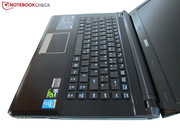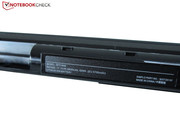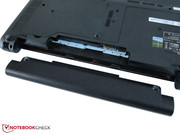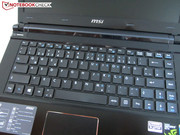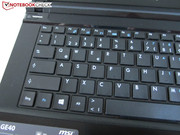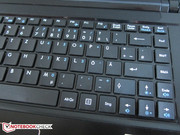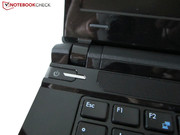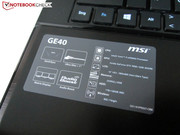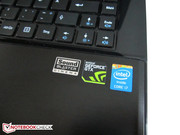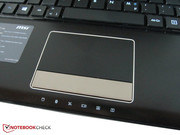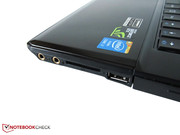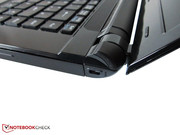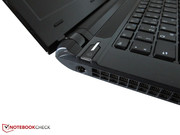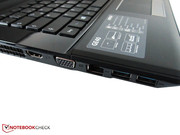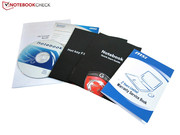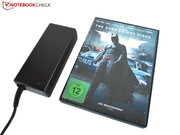Review MSI GE40-i760M2811 Notebook
For the original German review, see here.
Until recently, manufacturers rarely designed 13 or 14-inch notebooks to have gaming capabilities. But times have changed, and we are starting to see more and more flooding this successful segment of the notebook market. Computer experts like Alienware, Clevo, Gigabyte and Razer are all trying to find the ideal compromise between gaming potential and mobility.
With their GE40, MSI is working with a similar concept. The Internet shop notebooksbilliger.de, who provided us with our test device, is currently offering three versions of this notebook. The three differ in their RAM size, operating system and hard drive space. The top model, available for around 1200 Euros (~$1640), is the GE40-i760M2811. This article is based on the testing we performed on this model, which tries to draw customers with its 8 GB DDR3-RAM, Window 8 64-bit and a combination of 128 GB of storage on an mSATA SSD and 1000 GB on an HDD.
A prospective customer with a maximum budget of 1000 Euros (~$1370) could feasibly be content with the GE40-i760M285W7. To lower the price, MSI leaves out the SSD and installs the older Windows 7 (Home Premium 64-bit) rather than the newer Windows 8.
The GE40-i760M245FD is the least expensive of the three siblings. Yes, four GB of RAM and a 500 GB HDD are no longer the best of the best, but this 850 Euro (~$1160) version is an especially good option for customers who already own a Windows license, as FreeDOS is the only operating system on the hard drive.
All three models have a 14-inch non-glare panel with a resolution of 1600x900 pixels. The graphics cards and processors are also identical: While the Core i7-4702MQ is an energy-efficient quad-core from Intel's 22 nm generation, the GeForce GTX 760M is based on Nvidia's Kepler architecture (28 nm).
Before we get to the details, we have one more important comment. Behind what appears to be an optical drive faceplate on the top model, there is no DVD burner. According to the information we have, the only component present in that location is the SSD. According to customers, the entry-level model is shipped without even a faceplate.
| Model | GE40-i760M245FD | GE40-i760M285W7 | GE40-i760M2811 |
|---|---|---|---|
| Processor | Core i7-4702MQ | Core i7-4702MQ | Core i7-4702MQ |
| Graphics Card | GeForce GTX 760M | GeForce GTX 760M | GeForce GTX 760M |
| RAM | 4 GB DDR3 | 8 GB DDR3 | 8 GB DDR3 |
| Mass Storage | 500 GB HDD | 500 GB HDD | 128 GB mSATA-SSD + 1000 GB HDD |
| Optical Drive | not present | DVD Burner | not present |
| Display | 1600 x 900 Non-Glare | 1600 x 900 Non-Glare | 1600 x 900 Non-Glare |
| Operating System | FreeDOS | Windows 7 HP 64 Bit | Windows 8 64 Bit |
| Price | 850 Euros | 1000 Euros | 1200 Euros |
Case
As is typical for MSI, the notebook's case is no paragon of quality. As per usual, the manufacturer coated some of the case's surfaces (the display frame, keyboard bed and keyboard environment) with a high-gloss finish, which by no means helps to conceal dust and fingerprints. These blemishes start to build up on the case in no time.
If you are not extremely careful with the computer, you are certain to scratch the material sooner or later. The palm rest and lid, both constructed out of brushed aluminum, can only do so much to make up for this drawback.
We were not completely satisfied with the notebook's manufacturing either. In some spots the case's pieces do not fit together perfectly, though all in all the manufacturing quality is acceptable. The same goes for the computer's stability. While the base unit can stand up to a fair amount of pressure, the lid could certainly be stiffer. Still, the GE40 is not some shoddy device that threatens to fall apart any moment.
On a positive note, we would like to mention the case's compact construction. At a maximum height of three centimeters (~1.2 inches), the 14-inch notebook falls between the Gigabyte P34G (2.1 cm; ~0.8 inches) and the Alienware 14 (4.2 cm; ~1.7 inches). The device's weight is similar to that of the 17 mm (~0.7 inches) Razer Blade: 1.9 kilograms (~4.2 lbs) is a comfortable weight to carry around (P34G: ~1.8 kg, ~4.0 lbs; Alien 14: ~2.9 kg, ~6.4 lbs).
In terms of visual interest, MSI keeps things simple. Only the manufacturer's logo, the shiny silver strip under the touchpad (chrome look) and the "dragon eyes" on a red background add a touch of color to the device.
Connectivity
Ports
The connectivity options prove to be reasonably extensive. On the left side, MSI integrated a VGA/HDMI connection, an RJ-45 Gigabit LAN port and two USB 3.0 ports marked in blue. The right side houses a card reader, two audio jacks (headphones + microphone), a USB 2.0 port and a slot for a Kensington lock.
Because most of the connections are located on the front half of the device, some connections could get in the way of an external mouse. It would be better if the ports were positioned on the rear half of the case.
Communication
The network controller MSI chose proves that they take their target market seriously. Supposedly Qualcomm customized the Killer e2200 to meet the needs of online gamers (optimized handling of data traffic, etc.)
Realtek provides the notebook's wireless adapter. The RTL8723AE supports WLAN 802.11 b/g/n and Bluetooth 4.0. The GE did well in our reception range test. Over 10 meters (~33 feet) from the router and through several walls, the MSI device still showed 3-5 bars most of the time. Many notebooks only manage 1-2 bars -- if any -- at that distance.
Maintenance
Unfortunately, when we borrow devices with a warranty sticker from an Internet shop, we are not permitted to look under the maintenance hatch. But on the basis of our prior experience, we imagine MSI built their GE40 the same way they build most of their devices -- without any unnecessary hurdles between the user and the computer's important hardware components. This includes the 2.5-inch slot, the DDR3 RAM banks and the wireless module. The fan, graphics card and processor should also be easily accessible.
Software
Although MSI installs a variety of add-on programs, we would not (yet) say the system is bloated with software. For one, some of these programs are very practical, and secondly, the manufacturer does not load up the computer excessively with their own tools. We cover three examples from the notebook's software repertoire in more detail below.
Packaging
The items included in the GE40's packaging are currently standard for MSI. In the box you will find not only a driver DVD, a quick-start guide and a recovery manual, but also a warranty booklet plus corresponding cards. We especially like the small, 130 x 55 x 30 millimeter (~5.1 x 2.2 x 1.2 inch) power supply, though 90 Watts is a bold move on MSI's part (more on that later). The battery and power supply's moderate weight (~0.8 lbs) is another point in the GE40's favor.
Warranty
The notebook's warranty lasts two years. In Germany, a broken sticker should only be a problem if the device has been serviced unprofessionally and damaged in the process.
Input Devices
Keyboard
It takes a long time to get used to the chiclet keyboard. MSI starts on a good foundation with their freestanding and comfortably-sized keys (~15 x 15 mm), but the unrounded edges and unconventional layout substantially increase the likelihood of typing errors. Especially in the beginning, some buyers will be frustrated with the altered Enter key and the displaced ‘# and ><| keys (German layout; US English layout closer to standard). Also, during typing the keyboard sounds rickety and therefore cheaply made.
In terms of keyboard feedback, we have nothing to complain about. The computer recognizes most inputs immediately. MSI also deserves praise for their positioning of the special function keys. Both volume and brightness can be regulated in the snap of a finger using the arrow keys. Unfortunate: MSI chose not to light their keyboard.
Touchpad
If you forget its small size for a moment (80 x 43 mm; ~3.1 x 1.7 inches), the touchpad does its job well. The slightly textured surface guarantees decent feedback without hindering the finger's ability to glide across the pad. We are less enthusiastic about the soft scraping noise you hear while using the pad, which may irk some gamers.
On the other hand, the mouse substitute has good multi-touch support. With two-finger gestures, it is easy to scroll, zoom or turn documents, websites and images. Because the touchpad is set barely lower than the palm rest area, when you move off of the pad you only feel a minimal resistance. Speaking of resistance: The two click-keys, which are combined into one strip, could have a softer click-point for our taste.
Display
For 1200 Euros (~$1630) a consumer can reasonably expect a high-quality panel, like the AUO113D integrated into the Gigabyte P34G and Alienware 14. MSI apparently sees things differently and -- like Razer in their Blade 14 (AUO103E) -- equips their notebook with nothing more than an ordinary display, called an AUO303E.
| |||||||||||||||||||||||||
Brightness Distribution: 86 %
Center on Battery: 226 cd/m²
Contrast: 377:1 (Black: 0.6 cd/m²)
ΔE ColorChecker Calman: 11.39 | ∀{0.5-29.43 Ø4.78}
ΔE Greyscale Calman: 12.82 | ∀{0.09-98 Ø5}
43% AdobeRGB 1998 (Argyll 1.6.3 3D)
47.09% AdobeRGB 1998 (Argyll 3D)
67.6% sRGB (Argyll 3D)
45.92% Display P3 (Argyll 3D)
Gamma: 2.41
CCT: 16825 K
Compared to the Razer display, the GE40's black value is not quite as high (0.6 vs. 1.0 cd/m²), but the screen's brightness is a whole third lower: An average of 220 cd/m² is quite low, though you rarely need any more indoors. Outdoors, the situation is different. To properly work and surf the Internet outside on brighter days, the brightness value would need to be over 250 or better 300 cd/m². Still, for somewhat darker days (see photos), the brightness level is sufficient.
The test device delivered contrast of about 380:1, which is basically on par with the Razer Blade. While the Gigabyte P34G's contrast, at about 520:1, only comes in about a third ahead, the Alienware 14 outstrips them both massively at 900:1.
Another one of the GE40's weaknesses is its small color space: 63% sRGB and 43% AdobeRGB is rather restricted. Professional users will turn down the device for other reasons as well: Some of the grayscale, gamma and color accuracy deviate significantly from the ideal (see CalMAN screenshots).
Subjectively, the screen content does not look spectacular either. With everyday use, the limited viewing angles are especially frustrating. Even small changes in the viewing angle alter the screen content. The panel proves to be especially poorly suited to changes along the vertical axis.
In short: We strongly urge MSI to choose a different panel type. The matte and therefore mostly non-reflective surface is currently the screen's only strength.
Performance
As we mentioned in the beginning, an Intel Core i7-4702MQ serves as the computer's processor. At a TDP of 37 Watts, the processor uses 10 Watts less than the 200 MHz faster Core i7-4700MQ, which manufacturers install more frequently in notebooks.
Thanks to its Turbo Boost technology, the quad-core processor can increase its clock frequency under load to up to 3.2 GHz (base speed: 2.2 GHz). Hyperthreading is responsible for simulating four virtual cores. Together with the four real cores, eight threads can run in parallel. Six MB of L3 cache and 1.4 billion transistors also help the processing speed.
The integrated graphics chip does not go unused in the GE40: Nvidia's Optimus technology switches dynamically -- depending on the level of load -- between the HD Graphics 4600 and the GeForce GTX 760M, which is good for the computer in battery mode.
Turbo Boost
While the similarly constructed DevilTech Fire DT14 throttled severely, we did not observe any CPU throttling to about 1.0 GHz on our test device (extreme conditions). MSI probably updated the firmware or the BIOS.
2.7 to 3.1 GHz in single core applications and 2.4 to 2.9 GHz in the multi-core benchmarks do not quite reach the Core i7-402MQ's potential, but for such a thin and compact notebook, these numbers are respectable. Turbo mode only deactivates under full load, which is a rare scenario with normal gaming use.
CPU Performance
The results from most of the CPU benchmarks more or less matched our expectations. The Cinebench R15 test awarded the GE40 a single-core score of 124 points -- basically on par with the Nexoc B509II, which was also equipped with a Core i7-4702MQ in our tests (126 points). The processor's dual-core brother, the Core i5-4200M, computes about 10% slower (111 points in the HP Envy 15), while the 47 Watt model, the Core i7-4700MQ, runs about 6% faster (132 points in the Gigabyte P25W).
In the multi CPU test, the Haswell brothers drift further apart. With 534 to 298 points, the Core i7-4702MQ sprints about 80% ahead of the Core i5-4200M. The Core i7-4700MQ leads by about 10% (607 points).
| Cinebench R11.5 | |
| CPU Single 64Bit (sort by value) | |
| Core i7-4702MQ | |
| Core i5-4200M | |
| Core i7-4702MQ | |
| Core i7-4700MQ | |
| CPU Multi 64Bit (sort by value) | |
| Core i7-4702MQ | |
| Core i5-4200M | |
| Core i7-4702MQ | |
| Core i7-4700MQ | |
Graphics Card
A genuinely high-end model from Nvidia is responsible for bringing demanding 3D programs on to the screen fluidly. Like the GTX 765M, the GeForce GTX 760M has 768 shader units and 2048 MB of GDDR5 video memory at its command. It is connected via a 128-bit line and runs at an ample 1000 MHz. A disadvantage of the GTX 760M is its low core clock frequency: Instead of 850 MHz, it runs at a standard 628 MHz, though thanks to its GPU Boost technology it reaches up to 719 MHz (according to the GPU-Z tool).
In order to keep the computer at its maximum level of performance, we recommend updating the drivers frequently. The version 311.43 installed on our test device cannot exactly be referred to as new. Our benchmarks are based on the ForceWare version 331.82, which we downloaded directly from Nvidia's homepage. Except for a few blue screens, we did not have any trouble with the official WHQL driver.
| 3DMark 11 - 1280x720 Performance GPU (sort by value) | |
| GeForce GTX 760M (331.82) | |
| GeForce GT 750M DDR3 (311.54) | |
| GeForce GTX 760M (311.30) | |
| GeForce GTX 765M (311.54) | |
| 3DMark Vantage - 1280x1024 P GPU no PhysX (sort by value) | |
| GeForce GTX 760M (331.82) | |
| GeForce GT 750M DDR3 (311.54) | |
| GeForce GTX 760M (311.30) | |
| GeForce GTX 765M (311.54) | |
GPU Performance
Considering the notebook's size, its graphics performance is remarkable. An upper-middle class all-rounder with a GPU score of 2271 points in 3DMark 13's Fire Strike test is not something you see every day. The DDR3 version of the GT 750M scores about 30% lower (1574 points in the One K56-3F). The more expensive sibling, the GTX 765M, comes in with a 13% lead (2560 points in the One K33-3E).
In the Unigine Heaven 3.0 Benchmark (1920x1080, high, tessellation normal), the GPUs position themselves similarly. At 31.4 fps, the GTX 760M's frame rate lands about 40% higher than that of the 750M (22.3 fps) and 13% lower than the GTX 765M (36.3 fps).
| 3DMark Vantage P Result | 13255 points | |
| 3DMark 11 Performance | 3532 points | |
| 3DMark Ice Storm Standard Score | 70655 points | |
| 3DMark Cloud Gate Standard Score | 11347 points | |
| 3DMark Fire Strike Score | 2178 points | |
Help | ||
Mass Storage
In our test model, MSI combines an mSATA SSD with a 1000 GB HDD. We will address the Solid State Drive first. The SanDisk X110 SD6SF1M128G offers -- as the name suggests -- 128 GB of storage space.
Compared to other mSATA models, the X110 performs relatively poorly. At 227 MB/s, the sequential read rate does happen to fall between the 128 GB version of the Samsung SDD PM841 (127 MB/s in the Razer Blade) and the Liteonit LMT-128M6M (301 MB/s in the Gigabyte P34G), but at 265 MB/s, the drive's read write is fairly mediocre. The mSATA drives we just mentioned achieve speeds twice as high (~500 MB/s in the AS SSD benchmark). The competitors' 4K times and access speeds more closely approximate those of our test device.
Anyone who frequently transfers large amounts of data will be pleased with the conventional magnetic hard drive. For a 2.5-inch model with 5400 rpm, the WDC Blue WD10JPVX's performance is quite something. A maximum of 105-107 MB/s in CrystalDiskMark (sequential test) and an average of 82 MB/s in HDTune are unattainable numbers for most drives of this kind. All things considered, the SSD/HDD combination works well.
System Performance
Thanks to its Solid State Drive, the GE40 can boast of a very high system speed. 3437 to 4868 points in PCMark 8 is on par with the Razer Blade (3769 to 4800 points). 5185 points in PCMark 7 is also a good score, though both the Alienware 14 (5919 points) and the Gigabyte P34G (5951) profit from their quicker SSDs.
| PCMark 7 Score | 5185 points | |
| PCMark 8 Home Score Accelerated | 3437 points | |
| PCMark 8 Creative Score Accelerated | 4448 points | |
| PCMark 8 Work Score Accelerated | 4868 points | |
Help | ||
Gaming Performance
What seemed almost unthinkable a few years ago is now reality: You can play modern games at high details and activated anti-aliasing on a 14-inch device. If you can be content with a resolution of 1366x768 pixels if need be, even games that require a lot of processing power, like Assassin's Creed IV and Call of Duty: Ghosts, run fluidly on the GE40 (high/on, 2x MSAA).
At 1600x900 pixels, maximum details and 4x anti-aliasing, the notebook often wears itself out (the lower maximum values are based on 1920x1080 pixels). But all in all, the GE40's high gaming performance is very impressive -- almost unrivaled in the 14-inch market.
| Battlefield 4 - 1366x768 High Preset (sort by value) | |
| GeForce GTX 760M (331.82) | |
| GeForce GT 750M GDDR5 (326.80) | |
| GeForce GTX 760M (331.58) | |
| GeForce GTX 765M (331.65) | |
| low | med. | high | ultra | |
|---|---|---|---|---|
| Battlefield 4 (2013) | 96.1 | 65.8 | 47.1 | 18.7 |
| Call of Duty: Ghosts (2013) | 78.5 | 59 | 37.2 | 18.8 |
| Need for Speed: Rivals (2013) | 30 | 30 | 30 | 29.3 |
| Assassin´s Creed IV: Black Flag (2013) | 57.1 | 50.5 | 32 | 16.4 |
Emissions
System Noise
On the topic of emissions, we cannot reach a blanket conclusion, as the notebook's temperatures and noise level are extremely dependent on its level of load. In idle mode, the GE40 runs surprisingly quietly -- an observation confirmed by our measurements (~31 dB(A)). The fact that the fan and HDD occasionally increase the noise level to 32-33 dB(A) is by no means bothersome.
As soon as a 3D application is active, the GE40 is roused from its beauty sleep and whirs along at up to 50 dB(A) -- a hefty sound pressure level, but the competition gets there too (Alienware 14, Razer Blade and Gigabyte P34G). Even in 3DMark 06, which is not particularly demanding nowadays, our test device hit 42-46 dB(A) on various passes. Sensitive users should look at a 15 or 17-inch device with better cooling.
Noise level
| Idle |
| 31 / 31.2 / 32.8 dB(A) |
| HDD |
| 32.4 dB(A) |
| Load |
| 45.6 / 49.6 dB(A) |
 | ||
30 dB silent 40 dB(A) audible 50 dB(A) loud |
||
min: | ||
Temperature
The computer's temperatures leave us with mixed feelings as well. While the case remains very cool in idle mode (an average of 24 °C; 75.2 °F), cooler than the Gigabyte P34G and Alienware 14, during gaming the notebook warms up like no one's business. A maximum of 52 °C (125.6 °F) on the top side and 62 °C (143.6 °F) on the bottom of the case (after an hour under full load with FurMark and Prime95) speak for themselves. At over 40 °C (104 °F), the palm rest can also grow uncomfortably warm. Consequently, it would be better either to avoid long gaming sessions or to connect an external keyboard.
Things really heat up inside the case. Our hour-long stress test raised the CPU temperature to a maximum of 97 °C (206.6 °F) and the GPU temperature to up to 90 °C (194 °F). The Core i7-4702MQ generally lingered at its base clock rate. Only at the end of the stress test did the CPU throttle a little to about 2.0 GHz, but that throttling is understandable and should not occur during normal gaming sessions.
(-) The maximum temperature on the upper side is 53.8 °C / 129 F, compared to the average of 40.4 °C / 105 F, ranging from 21.2 to 68.8 °C for the class Gaming.
(-) The bottom heats up to a maximum of 62 °C / 144 F, compared to the average of 43.3 °C / 110 F
(+) In idle usage, the average temperature for the upper side is 23.7 °C / 75 F, compared to the device average of 33.9 °C / 93 F.
(-) The palmrests and touchpad can get very hot to the touch with a maximum of 44.1 °C / 111.4 F.
(-) The average temperature of the palmrest area of similar devices was 28.9 °C / 84 F (-15.2 °C / -27.4 F).
Speakers
MSI outfits the GE40 with two speakers, both located near the display under a fine grille. Even with Creative's Sound Blaster Cinema technology, which adapts to three practical scenarios (music, film and games) and should always be activated, the sound will not impress many users.
As is typical for notebooks, audio files sound thin, artificial and imprecise. Because the computer lacks a subwoofer, the sound is not balanced either -- low and bass tones are underrepresented. Bigger notebooks, like the HP Envy 15, often offer a better sound.
Energy Management
Power Consumption
In idle mode, the GE40's energy consumption level is very similar to that of the Razer Blade: 6-17 Watts is a pleasantly low range and shows the Alienware 14 (16-28 Watts) and the Gigabyte P34G (18-28 Watts) just how frugal a 14-inch device can be.
Under heavy load, these numbers multiply themselves. Even though the GE40 has to make do without a GTX 765M, in 3DMark 06 its energy usage climbs past that of the Blade 14 (76 vs. 68 Watts). The Gigabyte P34G and the Alienware 14 consume 87-93 Watts here. This is mainly because their processors have TDPs of 47 rather than 37 Watts.
At a maximum power consumption level of 109 Watts, the 90-Watt power supply is not big enough to keep up with the computer's energy usage under full load. Other companies would have provided the notebook with a 120-Watt power supply.
| Off / Standby | |
| Idle | |
| Load |
|
Key:
min: | |
Battery Life
The GE40's biggest highlight is its long battery life. Even though the 6-cell battery with 65 Wh (5900 mAh) is not going to win any prizes for its capacity, many buyers will be amazed at its capabilities. Just over 10 hours in idle mode (minimum brightness, maximum energy-saving profile) and 5.5 hours for surfing the Internet via WLAN (⅔ brightness, moderate energy settings) deserves applause. The competition runs for a maximum of 3-4 hours.
Playing games with the Nvidia GPU activated sinks the battery run time drastically. The notebook only had enough steam to chug along for 76 minutes in the Battery Eater Classic test, though its performance did remain stable.
Verdict
MSI has it difficult in the 14-inch compact gaming notebook market. Except for its good battery life, the GE40 cannot set itself apart from the (mostly more expensive) competition.
While the Razer Blade (85%) can win over potential buyers with its simple, thin and excellently manufactured body, and the Alienware 14 (86%) draws customers in with its modern look, broad range of connectivity options and good brightness, the GE40 flounders in mediocrity.
The display, keyboard, touchpad, speakers and case quality could all stand to be improved. In our opinion, the high-gloss sections of the case that collect dust and fingerprints are also a shortcoming. Anyone looking for a quiet and cool gaming partner is in the wrong place here: While 3D applications are running, the notebook grows very loud and warm.
MSI deserves praise for the small power supply, potent mSATA SSD and HDD combination, and how easy it is to service the computer. The manufacturer also earns respect for the notebook's powerful hardware: Packing a GeForce GTX 760M and a quad-core processor in a three-centimeter high case takes guts.
Gamers who like to travel and are frequently on the go, or at least move their laptop around frequently, may find what they are looking for here. Personally, despite its higher price, the author favors the Gigabyte P34G (84%). The 13-inch Clevo W230ST Barebones (One K33-3E) is also a good alternative.






